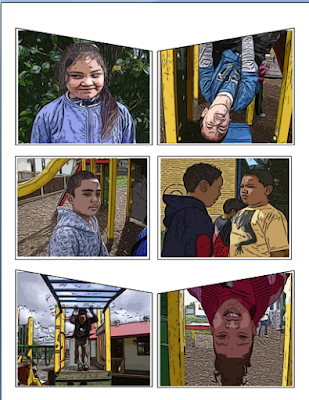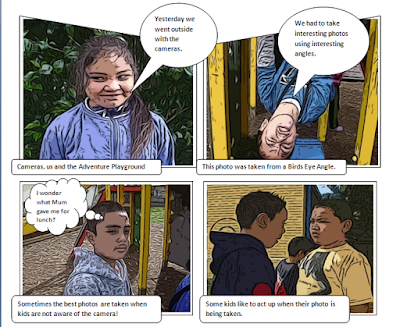I was working with a wonderful young teacher at Willowbank school last week. She was recording the children's voices in Garageband while they read their book Aunty Mo's Kids by Jill Eggleton. They had recorded reading it in theatre style. Now they were adding sounds to it. While they were working together I came to a realisation and said to the teacher "Do you know what you are doing here? You have moved from the traditional teacher and students sitting on the mat guided reading lesson to the student centred, teacher facilitated using technology guided reading collaboration."
This teacher had been using all the 'Guided Reading' steps of responding to and discussing text
while the students were in front of the computer, reading their books, searching for words and sentences in context, recording voices and sounds, learning computer skills, collaborating together and creating an audiobook that they will be able to use in their classroom as an extra activity (with iPods) and share with other classes.
As I said to her, "this is another way of teaching and engaging children in learning, that you do not have to teach always in the traditional style. Your activity could also become your teaching time with the children."
As teachers we have to be brave and let go or adjust some of our traditional delivery methods to incorporate the use of technologies such as computers, cameras, iPods, IWB's, game consoles, or Flip videos. The children will be engaged, on task and learning, you as the teacher will see different aspects of your children as they become more animated and in control of their learning.
Tuesday, May 26, 2009
Friday, May 22, 2009
Creating Comics in Word

I was working with a teacher today who said he was going to make comics in Word.
To make it look more like a comic, upload your photos to Befunky and cartoonise them. Click on Get Started, click on Cartooniser, click on Browse files, select a photo
 , click Open, rotate or crop if necessary, click OK and your photo will appear. Click Save, name your photo and click Save to My desktop, click OK you may be asked to Save again. You may want to crop the white border of the photo
, click Open, rotate or crop if necessary, click OK and your photo will appear. Click Save, name your photo and click Save to My desktop, click OK you may be asked to Save again. You may want to crop the white border of the photoI had previously already showed him how to insert Autoshapes onto a page
 , I usually insert six to a page. Then you click on a shape, go to the Fill can, choose Fill Effects, click on th
, I usually insert six to a page. Then you click on a shape, go to the Fill can, choose Fill Effects, click on th e Picture Tab, click on Choose Picture, select a photo and click Insert.
e Picture Tab, click on Choose Picture, select a photo and click Insert.Once the pictures are inserted then you need to add the speech bubbles and narrative text boxes. This is a wonderful way of publishing children's writing.
You can also do the same thing in PowerPoint but put one photo on each slide and it becomes a Comic Slideshow.
ICT Kids
View more presentations from Jacqui Sharp.
Labels:
befunky,
cartoon,
comics,
juniors,
literacy,
PowerPoint,
Publishing,
Word
Tuesday, May 12, 2009
Transformations in the 21st Century Digital Environment
This is a slideshow I presented at a recent ICT Cluster Conference. It is an overview of the eight days I spent in a Year 5/6 class.
Keynote Speech Presentation
View more presentations from Jacqui Sharp.
Friday, May 8, 2009
Audiobooks, Instructional Readers & Shared Books



There are lots of Audiobooks available for download online on iTunes, but rarely the one you want! Harry Potter books are available on the US iTunes site but not on our NZ iTunes (What's up with that?)
But if you have an iPod , a 5 way splitter
Belkin Rockstar
(NZ $20) and cheap headphones (NZ $2.99) then you can create absorbing reading activities for your students.
Record your voice in GarageBand (Mac) or Audacity (Win), upload to iTunes and download to your iPod.
Kids love the iPods and the headphones and this makes for a very 'q-u-i-e-t' activity!
More Ideas
- Do you know somebody who has an interesting, expressive voice, ask them to read for you and record them
- Record in theatre reading style where you have different voices reading the parts of the characters and narrator
- Junior teachers ask teachers of Senior children to get their students to record some of your instructional readers or shared books
- More able readers in the class can create audiobooks for less able students
- Keep a box of the books/Journals/Instructional readers that you have recorded so that children can choose their favourite story to listen to
Subscribe to:
Comments (Atom)